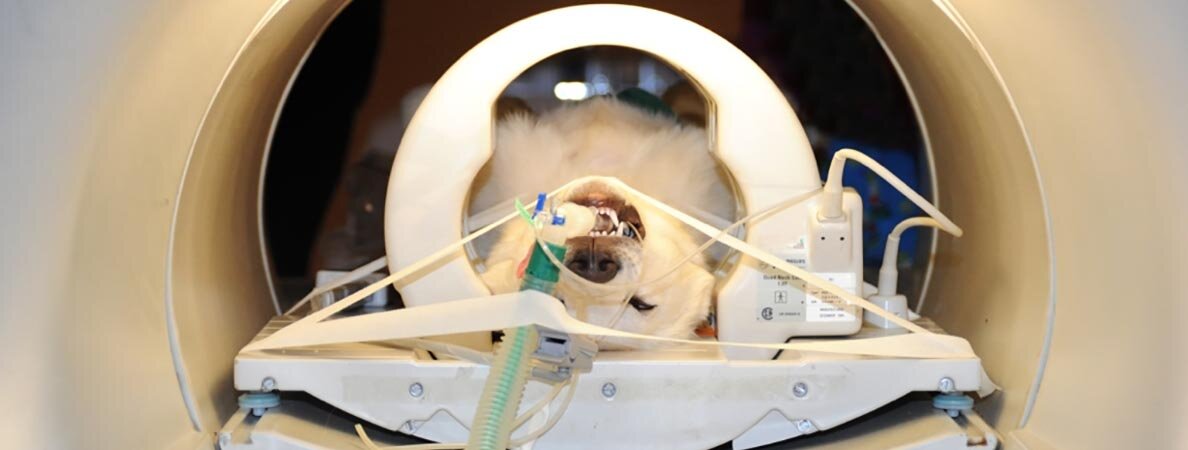Pet Blog > When Your Dog Needs An MRI: What The Test Reveals
When Your Dog Needs An MRI: What The Test Reveals
Up until a few years ago, various medical technologies were only available for applications in human medicine. Now, however, they have applications in veterinary medicine as well. One example of this is an Magnetic Resonance Imaging (MRI). An MRI is essential to test for any underlying diseases or disorders your dog may be suffering from. This technique provides detailed images of your pet's tissues. This device uses powerful radio and magnetic waves to create an image of a particular body part. With an MRI, the veterinary doctor can create clear images of your dog's nervous system. They can get a view of your pup's nerves, spinal cord, and brain.
Doctors use MRI scans for detailed diagnosis. To conduct a less intensive diagnosis, they use ultrasound or x-rays. MRIs create images of the entire body, enabling the doctor to visualize the spine and skull's deeper areas. However, it is impossible to perform such detailed analysis using techniques besides MRI imaging.
The equipment necessary to perform veterinary MRI is expensive and specialized. Therefore, only specific hospitals use this technology under the supervision of expert veterinarians. Furthermore, doctors also use this machine for the training process in the universities. The equipment is costly, and the use of anesthesia for diagnosis makes this device expensive. Although the price of veterinary technology varies throughout the country, hospitals charge between $2,000 and $3,500 to perform an MRI. However, your dog will only need diagnosis and treatment with this valuable tool if their condition is critical.
When your dog needs an MRI
MRI scans are not a screening procedure, but doctors use them for diagnosis. Veterinary doctors don't recommend this for healthy dogs. MRIs help in diagnosing conditions pertaining to the spinal cord or brain. But this is only if other diagnosis procedures, such as x-rays and ultrasounds, couldn't identify the disease. Your dog will require an MRI scan for:
Spinal cord disorders, which involve the diagnosis of stenosis, herniated discs, spinal tumors, and nerve root impingement.
Brain diseases such as infarcts, tumors, inflammation, abscesses of the brain.
MRI is essential to identify neurological problems such as abnormal gait or seizures. Veterinary doctors use this technique to determine the root cause behind organic brain lesions, such as brain tumors. This advanced technological device is also helpful in diagnosing problems of the joints and bones. There are numerous benefits of using this technology for patients, but there are various downsides as well:
Due to expensive equipment, this machine is available at limited centers and veterinary schools. Furthermore, specialty centers need a referral from the veterinarian to install the machine in their facility.
The cost of running the machine for one scan is $2,500, which is very costly.
It requires anesthesia as the dog would not be able to move from the position throughout the scan.
CAT Scan
A CT scan for humans and pets is identical. The equipment and tools are the same, but the procedure is different. The pet will require anesthesia to undergo the procedure as they need to be completely still. When a veterinarian suspects an issue that they cannot understand and visualize through x-rays, they recommend a CT scan for your dog. Doctors perform a CAT scan when your dog experiences sinuses and other abnormalities of head and lung conditions. But, they can diagnose any body part through a CAT scan.
The doctor will use anesthesia while performing a CT scan because they have to hold your dog in a position for the entire procedure. They will also inject a contrast agent into the veins of your dog. This agent will enhance the view of the blood vessels and soft tissues. The doctor will lay your dog on the table that slides inside the CAT machine. This machine is round in shape with a hollow center. As your pup passes through the machine, the doctor will take x-ray images from multiple angles. They will either perform a CT scan of one part of the body or a complete body scan. After they gather all the images, your dog can regain consciousness. The radiologist will manipulate images on the computer and perform a diagnosis.
X-ray or Ultrasound
X-rays do not induce any pain as a machine obtains images of your pet's body. The image will separate the different densities of the tissues with gray, black, and white. The doctor uses this device for diagnosing numerous problems such as broken bones, arthritis, swallowed items, digestive tract, cancer, and various infections. X-rays are less expensive and invasive in contrast to ultrasounds. The doctor will recommend X-rays for your dog if they need to evaluate the dense bone structure and structures filled with air-like lungs.
Ultrasounds consist of high-frequency sound waves that produce the image of small and large organs inside your dog's body. The doctor will recommend ultrasound for soft tissues such as gall bladder, intestines, stomach, heart, bladder, kidneys, pancreas, and liver. Ultrasound also helps diagnose tiny glands such as adrenal glands and lymph nodes in your abdomen. With an ultrasound, doctors can evaluate the interior and exterior surface of organs. Ultrasounds cannot diagnose air-filled and denser organs as sound waves can't travel through these structures. Ultrasound and X-rays show different information to the doctor, so they might use both technologies to diagnose specific diseases in your pup.
Do you know what the Tests Reveal?
Here are some of the benefits of MRI technology for your dog:
It distinguishes the disease from the normal tissues
It helps to track nerve fibers of the spine and the brain
Identify the brain tumors without the use of biopsy
Determining if the doctor can treat the tumor with radiation therapy or surgery
Conclusion
MRI machines are among the latest technologies that veterinary healthcare departments are utilizing for diagnosis. This machine is expensive, and therefore the accompanying vet bill may be also, but is extremely effective in contrast to other diagnosis devices. The doctor will recommend this test for your dog if other scanning methods are not helpful.
Check out the other “Dog Blog” articles
Return to the Pet Blog

